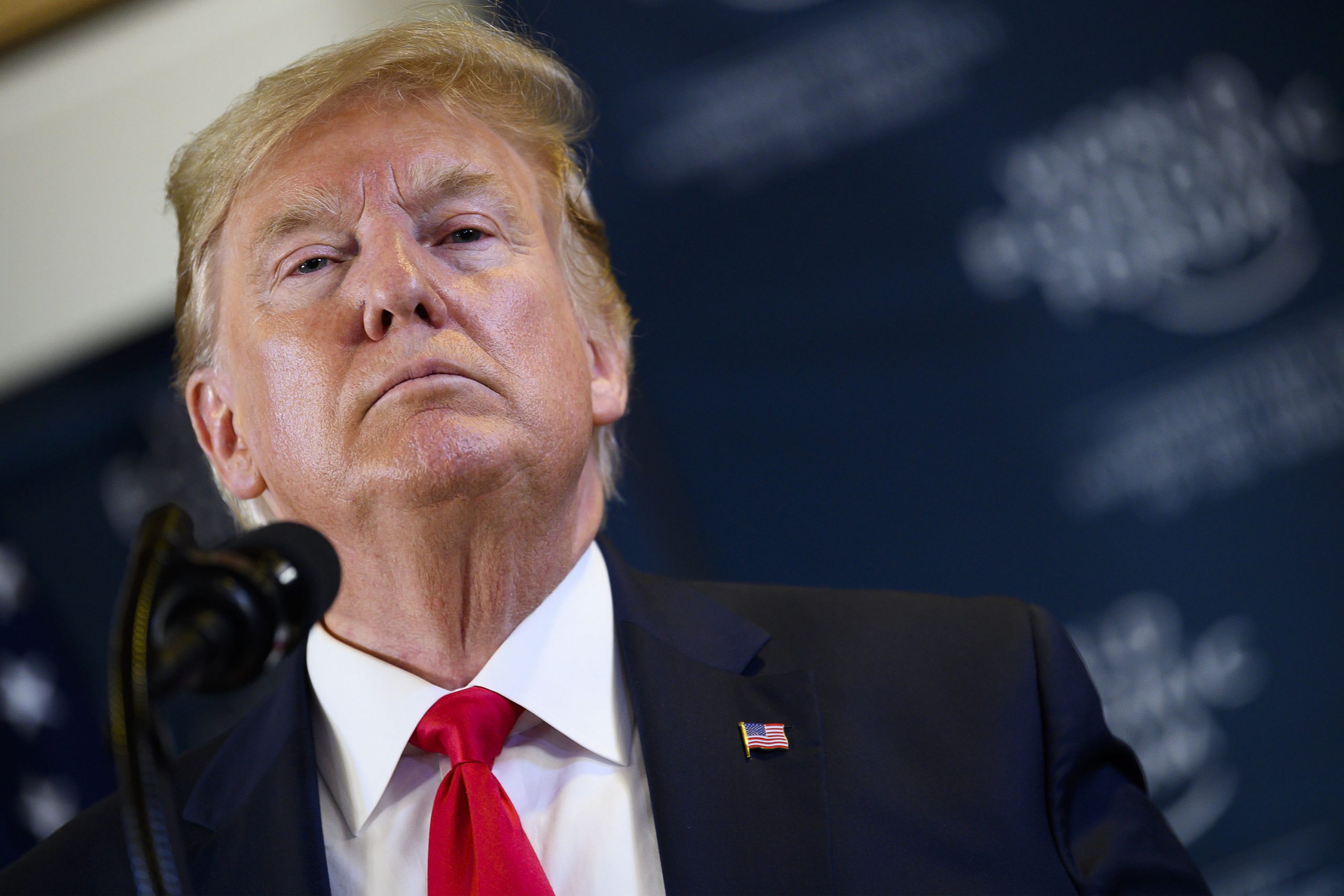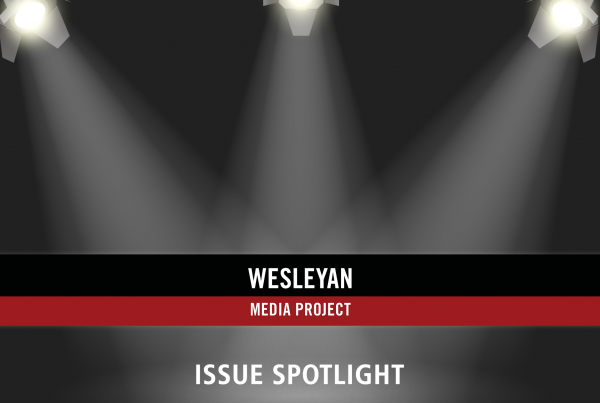Photo: Jim Watson/AFP
Digital Spending at $84.6 Million in Presidential Race
(MIDDLETOWN, CT) October 24, 2019 – Television ad spending by presidential candidates has ramped up over the past six weeks, according to a new analysis by the Wesleyan Media Project. Presidential candidates have spent over $22 million on television ads since September 12 (Table 1). That spending represents nearly 60 percent of the total spent on presidential TV ads in 2019.
TV spending has been driven largely by Tom Steyer, who has spent over $14 million on ads since September 12. That accounts for almost 60 percent of his total spending in the presidential race.
Table 1: TV Ad Airings and Spending by Candidate (Full Year and Since September 12)
| Candidate | Airings (since Jan. 4) | Spending ($) (since Jan. 4) | Spending ($) (since Sept. 12) |
|---|---|---|---|
| Tom Steyer | 59,615 | 27.3M | 14.3M |
| Donald Trump | 2,540 | 5.4M | 5.0M |
| Pete Buttigieg | 1,960 | 1.2M | 1.0M |
| Bernie Sanders | 1,623 | 0.8M | 0.8M |
| Michael Bennet | 1,214 | 0.6M | 0.6M |
| Amy Klobuchar | 509 | 0.4M | 0.4M |
| Joe Biden | 883 | 0.6M | 0.2M |
| Joe Sestak | 59 | 18,100 | 18,100 |
| Julián Castro | 23 | 6,200 | 0 |
| John Delaney | 1,431 | 0.5M | 0 |
| Tulsi Gabbard | 1,302 | 0.5M | 0 |
| Kirsten Gillibrand | 2,788 | 1.1M | 0 |
| Mike Gravel | 5 | 7,700 | 0 |
| Kamala Harris | 810 | 0.4M | 0 |
| TOTAL | 74,762 | 38.8M | 22.5M |
| Numbers include ads aired on national network, national cable and broadcast television between January 5 and October 20, 2019 and between September 13 and October 20, 2019. Spending totals for candidates may differ from our prior report due to changes in Kantar/CMAG estimates of total spending. CITE SOURCE OF DATA AS: Kantar/CMAG with analysis by the Wesleyan Media Project. |
|||
Trump Launches $5 Million Attack Ad Blitz
Donald Trump’s campaign has also boosted its television spending. Since October 1, Trump has spent just under $5 million on ads that have both attacked Joe Biden for alleged corruption and attacked Democrats for launching an impeachment investigation against him. The ads have aired on local television in Iowa, New Hampshire, South Carolina and Nevada media markets. They have also aired nationally on the networks (ABC, CBS, FOX and NBC) and cable (including Bravo, CNN, Fox News, Investigation Discovery, MSNBC and TBS). Much of his digital spending messaging was also focused on the same issues.
“This is a huge advertising buy for an incumbent president so early in the campaign,” said Mike Franz, co-director of the Wesleyan Media Project. “It appears that Trump’s attacks on Biden are designed to soften up Biden for the general election or ensure that someone other than Biden becomes the Democratic nominee.”
Warren, Harris off the Air;
Sanders, Bennet, Klobuchar Start Airing Ads
Elizabeth Warren, who is neck-and-neck with Joe Biden for the lead in most polls of the Democratic nomination, has yet to spend a single dollar on television advertising. Kamala Harris, who has generally fallen in the polls, has not bought television advertising in the past six weeks, in spite of spending earlier during the year.
“Warren has been gaining steadily in the polls in spite of not being on television,” said Travis Ridout, co-director of the Wesleyan Media Project. “I think this speaks to her ability to garner free media coverage—and getting her message across on social media.”
At the same time, three Democratic candidates have recently started airing ads. Michael Bennet’s campaign started airing ads in Des Moines and Cedar Rapids, Iowa, on September 17. Bernie Sanders started airing ads in several Iowa media markets on September 18. Amy Klobuchar’s campaign launched its first TV ad on October 3 and has aired ads in Iowa and New Hampshire.
Trump Leads Digital Ad Spending
In addition to the $5 million that Trump has spent on television advertising since September 12, he has spent over $6.8 million on digital advertising, making him the top digital advertiser in the race during that period of time (Table 2). Tom Steyer was second, with $3.1 million in Facebook and Google ad spending, followed by Pete Buttigieg with $2.1 million in spending on the two platforms and Elizabeth Warren with $1.7 million in spending. Beto O’Rourke, who spent multi-millions on Facebook ads during his 2018 Senate run in Texas, has spent only $109,000 on Facebook and Google ads over the past six weeks—and well under $2 million throughout his entire presidential campaign.
Table 2: Facebook and Google Spending by Sponsor (Full Year and Since Mid-September)
| Sponsor | Facebook Spending ($) | Google Spending ($) | Total ($) | Total ($) (since mid-Sept) | ** |
|---|---|---|---|---|---|
| Donald Trump^ | 14,855,027 | 8,603,400 | 23,458,427 | 6,873,919 | 1 |
| Tom Steyer | 7,046,590 | 2,816,400 | 9,862,990 | 3,120,125 | 2 |
| Pete Buttigieg | 4,593,324 | 2,257,800 | 6,851,124 | 2,074,550 | 3 |
| Elizabeth Warren | 3,639,556 | 2,530,800 | 6,170,356 | 1,676,254 | 4 |
| Bernie Sanders | 3,975,453 | 1,230,900 | 5,206,353 | 1,003,666 | 5 |
| Joe Biden | 2,695,426 | 1,197,900 | 3,893,326 | 623,011 | 6 |
| Kamala Harris | 2,231,910 | 1,502,700 | 3,734,610 | 569,941 | 7 |
| Kirsten Gillibrand | 2,792,358 | 515,800 | 3,308,158 | 0 | 8 |
| Cory Booker | 1,936,837 | 571,200 | 2,508,037 | 144,565 | 9 |
| Amy Klobuchar | 2,020,709 | 424,000 | 2,444,709 | 189,261 | 10 |
| Julián Castro | 1,798,944 | 185,100 | 1,984,044 | 100,735 | 11 |
| Beto O'Rourke | 952,964 | 696,500 | 1,649,464 | 109,351 | 12 |
| Andrew Yang | 1,346,673 | 260,000 | 1,606,673 | 99,902 | 13 |
| Tulsi Gabbard | 614,138 | 955,100 | 1,569,238 | 222,626 | 14 |
| Jay Inslee | 895,626 | 345,600 | 1,241,226 | 0 | 15 |
| Marianne Williamson | 1,006,984 | 224,900 | 1,231,884 | 19,273 | 16 |
| Michael Bennet | 841,668 | 38,400 | 880,068 | 77,048 | 17 |
| John Hickenlooper | 485,481 | 119,700 | 605,181 | 43,502 | 18 |
| Steve Bullock | 282,785 | 145,600 | 428,385 | 41,424 | 19 |
| John Delaney^^ | 204,374 | 185,900 | 390,274 | 100 | 20 |
| Seth Moulton | 232,354 | 62,000 | 294,354 | 1,124 | 21 |
| Eric Swalwell | 128,846 | 86,600 | 215,446 | 0 | 22 |
| Bill de Blasio | 105,873 | 64,700 | 170,573 | 17 | 23 |
| Tim Ryan | 62,459 | 107,500 | 169,959 | 1,263 | 24 |
| Mike Gravel | 115,423 | 4,500 | 119,923 | 0 | 25 |
| Bill Weld | 25,510 | 0 | 25,510 | 0 | 26 |
| Wayne Messam | 11,015 | 5,500 | 16,515 | 0 | 27 |
| Joe Sestak | 641 | 0 | 641 | 0 | 28 |
| 29 | |||||
| Need to Impeach (pro-Steyer) | 1,891,717 | 2,072,600 | 3,964,317 | 40,880 | 30 |
| Act on Climate Now (pro-Inslee) | 439,757 | 87,900 | 527,657 | 0 | 31 |
| Great America PAC (pro-Trump) | 95,014 | 6,900 | 101,914 | 4,364 | 32 |
| Draft Beto (pro-O'Rourke) | 9,898 | 0 | 9,898 | 0 | 33 |
| 34 | |||||
| Candidate Total | 54,898,948 | 25,138,500 | 80,037,448 | 16,991,755 | 35 |
| Super PAC Total* | 2,436,386 | 2,167,400 | 4,603,786 | 47,044 | 36 |
| GRAND TOTAL | 57,335,334 | 27,305,900 | 84,641,234 | 17,038,799 | 37 |
| Figures come from the Facebook ad library reports and the Google Transparency Report. For Facebook, spending covers the period January 6, 2019 (or September 13, 2019) to October 20, 2019; Google spending covers the period January 6, 2019 (or September 15, 2019) to October 12, 2019. Candidate numbers include spending by official campaign committees, leadership PACs, and joint fundraising committees. For some candidates, totals also include spending from their Senate or House campaign accounts. ^Includes $1.4M in spending on Mike Pence’s Facebook page. ^^Includes $1,930 in spending on April McClain-Delaney’s Facebook page. *Super PACs supportive of particular candidates are listed separately. The row "Super PAC Total" includes just the four super PACs listed in this table. Some spending by Need to Impeach occurred before Steyer officially entered the presidential race. **The final column can be used to return to the original sorting of the table. See About the Data section at the end of this report for more info on our methodology. |
|||||
All told, about $17 million has been spent on digital advertising since mid-September, about $5 million less than was spent on television advertising during the same period. Since the beginning of 2019, candidates (and single-candidate super PACs and leadership PACs) have spent almost $85 million on digital advertising in the presidential race on just two platforms, Facebook (including Instagram) and Google (including YouTube).
“Although we expected digital advertising to grow this cycle, the extent to which it has taken off is astounding,” said Erika Franklin Fowler, co-director of the Wesleyan Media Project. “We expect to see healthy spending on digital until Election Day in November 2020, though at some point, spending on television ads will start outpacing digital spending.”
Steyer Outspends All Others in 2020 Presidential Advertising
Figure 1 shows total spending on television and digital (Facebook and Google) advertising by each candidate. Tom Steyer has now spent more than any other candidate, despite being in the presidential race only since July, even outspending Donald Trump on political advertising. Steyer has spent more than $37 million on advertising in just a few months. Trump has spent almost $29 million, while Buttigieg is a distant third in total ad spending—about $8 million. Warren and Sanders round out the top five spenders.
Figure 1: TV and Digital Spending by Candidate
Digital figures come from the Facebook ad library reports and the Google Transparency Report.Spending covers the January 6, 2019 to October 20, 2019 period for Facebook. Google spending covers the January 6, 2019 to October 12, 2019 period.
Candidate numbers include spending by official campaign committees, leadership PACs, and joint fundraising committees. For some candidates, totals also include spending from their Senate or House campaign accounts. Super PACs supportive of particular candidates are not included.
TV data come from Kantar Media/CMAG and include candidate-sponsored ads aired on national network, national cable and broadcast television between January 6 and October 20, 2019.
See About the Data section at the end of this report for more information on our methodology.
Data visualization work by Kevin McMorrow ’20.
About the Data
For the television ad totals, data reported here are from Kantar/CMAG and do not cover local cable buys, only broadcast television, national network and national cable advertising.
For Facebook ads, data come from daily or weekly aggregated reports. Aggregate report entries are provided for each page name and disclaimer combination. In early January 2019, Facebook did not include page IDs (a unique identifier) for each entry in the aggregate report. Because pages can have the same name, a unique identifier for each page would be required to definitively identify an aggregate report entry, which Facebook has declined to provide going backward. Therefore, we did our best to associate each entry in the January 5, 2019, report with a page ID, which we had access to through the library API. There may be some slippage if two pages associated with presidential candidates had identical names and disclaimers, but we believe these instances are rare for the set of ads covered in this report. We looked for pages attached to each candidate, including possible leadership PACs, joint-fund-raising committees, and affiliated Senate/House pages. To calculate our totals for this report, we used the 1/5/19 report and merged on the 10/20/19 report totals. In each report, Facebook provides the to-date totals for each row, which covers the full archive back to May 2018. We subtracted the 1/5/19 total from the 10/20/19 total to get the spending by page and disclaimer for January 6 through October 20, 2019. Pages can sponsor ads that are funded by different entities. We made the assumption that all spending by federal office-holders running for president in 2019 (e.g., Kamala Harris) was in support of their presidential campaign, even if some spending was reported from their House or Senate page or leadership PAC, especially because many of the leadership PAC spending occurred on the same pages as the campaign spending. We separate Tom Steyer’s totals from Need to Impeach because he is not currently an elected official, and Need to Impeach ran anti-Trump ads before Steyer announced his run for the Democratic nomination (Need to Impeach is also a super PAC). Advertising run from pages known to be associated with presidential candidates are included even in instances where the ads ran without an appropriate disclaimer.
In Table A (click here to download), we list the page names/disclaimer rows from the aggregated reports that we identified for this report. It is possible that we missed some spending from a Facebook page affiliated with a candidate running for office. This is exacerbated by the absence of EIN or FEC identifiers in the Facebook reports.
For Google ads, we downloaded the weekly reports from the platform’s Transparency Report. Google only includes spending in federal races and only includes weekly totals but lists the sponsor’s EIN or FEC committee ID. We searched the list of advertisers for presidential candidates and affiliated leadership PACs and joint-fund-raising committees. We made the same assumption as with the Facebook data about any spending from House and Senate campaign committees by declared presidential candidates. As of September 16, 2019, Google’s transparency report was only updated through the week starting August 25, 2019; therefore we can only report on Google spending from January 6, 2019 through August 31, 2019.
In Table B (click here to download), we list the advertiser name for all entries used in this report to calculate Google candidate totals.
About This Report
The Wesleyan Media Project (WMP) provides real-time tracking and analysis of political advertising in an effort to increase transparency in elections. Housed in Wesleyan’s Quantitative Analysis Center (QAC) – part of the Allbritton Center for the Study of Public Life – the Wesleyan Media Project is the successor to the Wisconsin Advertising Project, which disbanded in 2009. It is directed by Erika Franklin Fowler, associate professor of government at Wesleyan University, Michael M. Franz, professor of government at Bowdoin College and Travis N. Ridout, professor of political science at Washington State University. WMP personnel include Laura Baum (Project Manager), Colleen Bogucki (Project Coordinator), Pavel Oleinikov (Associate Director, QAC), and Courtney Page-Tan (Post-Doctoral Fellow).
The Wesleyan Media Project is supported by Wesleyan University, the John S. and James L. Knight Foundation, and the Democracy Fund. WMP is partnering again this year with the Center for Responsive Politics, to provide added information on outside group disclosure.
Periodic releases of data will be posted on the project’s website and dispersed via Twitter @wesmediaproject. To be added to our email update list, click here.
For more information contact:
Lauren Rubenstein, lrubenstein@wesleyan.edu,
(860) 685-3813 or (203) 644-7144
About Wesleyan University
Wesleyan University, in Middletown, Conn., is known for the excellence of its academic and co-curricular programs. With more than 2,900 undergraduates and 200 graduate students, Wesleyan is dedicated to providing a liberal arts education characterized by boldness, rigor and practical idealism. For more, visit wesleyan.edu.
About the John S. and James L. Knight Foundation
Knight Foundation is a national foundation with strong local roots. We invest in journalism, in the arts, and in the success of cities where brothers John S. and James L. Knight once published newspapers. Our goal is to foster informed and engaged communities, which we believe are essential for a healthy democracy.
About Democracy Fund
Created by eBay founder and philanthropist Pierre Omidyar, Democracy Fund is a foundation helping to ensure that our political system can withstand new challenges and deliver on its promise to the American people. Democracy Fund has invested more than $125 million in support of a healthy, resilient, and diverse democracy with a particular focus on modern elections, effective governance, and a vibrant public square.




